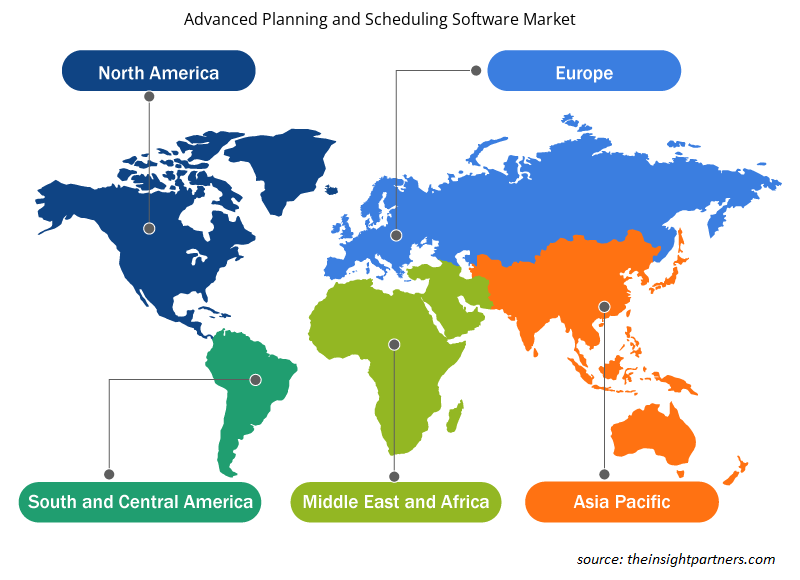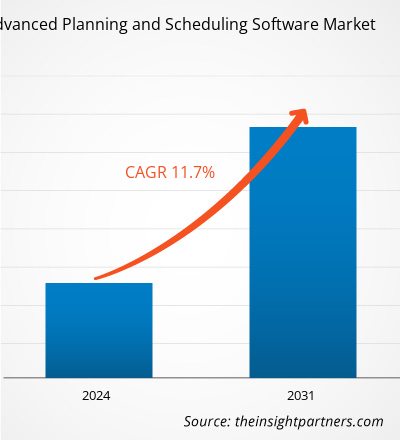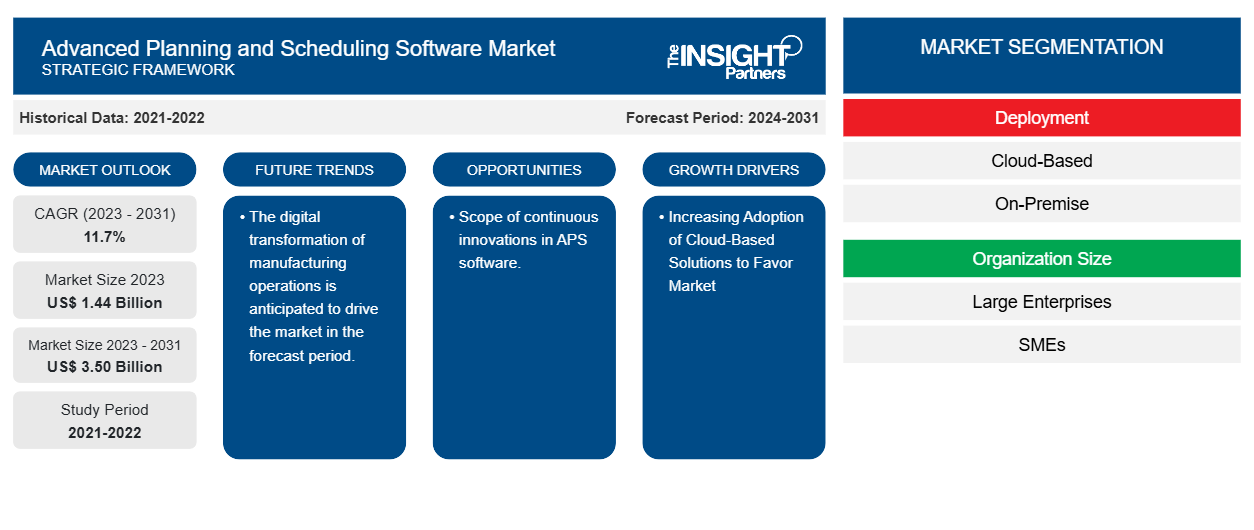من المتوقع أن يصل حجم سوق برامج التخطيط والجدولة المتقدمة إلى 3.50 مليار دولار أمريكي بحلول عام 2031 من 1.44 مليار دولار أمريكي في عام 2023. ومن المتوقع أن يسجل السوق معدل نمو سنوي مركب بنسبة 11.7٪ خلال الفترة 2023-2031. ومن المرجح أن تظل الحاجة المتزايدة إلى تحسين عملية الإنتاج الإجمالية والتبني المتزايد للحلول المستندة إلى السحابة من الاتجاهات والدوافع الرئيسية في السوق.
تحليل سوق برامج التخطيط والجدولة المتقدمة
يشهد سوق برامج التخطيط والجدولة المتقدمة نموًا كبيرًا على مستوى العالم. ويعزى هذا النمو إلى الحاجة المتزايدة إلى تحسين عملية الإنتاج الإجمالية والتبني المتزايد للحلول المستندة إلى السحابة. علاوة على ذلك، من المتوقع أن يحمل النطاق المتزايد للابتكارات المستمرة في برامج التخطيط والجدولة المتقدمة والتحول الرقمي لعمليات التصنيع العديد من الفرص للسوق في السنوات القادمة.
نظرة عامة على سوق برامج التخطيط والجدولة المتقدمة
يعد التخطيط والجدولة المتقدمان (APS) حلاً يساعد الشركات المصنعة على التحكم في تخطيط الإنتاج وجدولة أرضية المصنع. باستخدام خوارزميات متقدمة لموازنة الطلب والقدرة وإنتاج جداول إنتاج قابلة للتحقيق، تؤدي برامج التخطيط والجدولة المتقدمة إلى أوقات تسليم أسرع لتلبية متطلبات العملاء واستجابات أسهل وأسرع للتغييرات غير المتوقعة في الإنتاج.
قم بتخصيص هذا التقرير ليناسب متطلباتك
ستحصل على تخصيص لأي تقرير - مجانًا - بما في ذلك أجزاء من هذا التقرير، أو تحليل على مستوى الدولة، وحزمة بيانات Excel، بالإضافة إلى الاستفادة من العروض والخصومات الرائعة للشركات الناشئة والجامعات
-
احصل على أهم اتجاهات السوق الرئيسية لهذا التقرير.ستتضمن هذه العينة المجانية تحليلاً للبيانات، بدءًا من اتجاهات السوق وحتى التقديرات والتوقعات.
محركات وفرص سوق برامج التخطيط والجدولة المتقدمة
تزايد اعتماد الحلول المستندة إلى السحابة لصالح السوق.
إن زيادة اعتماد الحلول المستندة إلى السحابة هي في الواقع محرك نمو سوق برامج التخطيط والجدولة المتقدمة. يعتمد نظام التخطيط والجدولة المتقدم المستند إلى السحابة (CAPS) على التخطيط والجدولة الديناميكي الذكي (IDPS)، والذي يتكون من خمس وحدات رئيسية، بما في ذلك الإدخال والمحاكاة وتخطيط السعة (CP) وتحليل تأثير السعة (CIA) والإخراج. بالإضافة إلى ذلك، تستهلك حلول APS المستندة إلى السحابة استثمارات مباشرة منخفضة مقارنة بالحلول المحلية. وهذا يزيد من الطلب على منظمات برامج التخطيط والجدولة المتقدمة، بما في ذلك الشركات الصغيرة والمتوسطة الحجم. وبالتالي، بالنظر إلى المعايير المذكورة أعلاه، فإن الاعتماد المتزايد على الحلول المستندة إلى السحابة هو محرك نمو سوق برامج التخطيط والجدولة المتقدمة.
نطاق الابتكارات المستمرة في برمجيات APS.
إن نطاق الابتكارات المستمرة في برامج APS يحمل فرصًا كبيرة للسوق. يمكن أن تؤدي الابتكارات المستمرة إلى دمج الخوارزميات التكيفية للقدرات مع أنظمة مثل ERP وMES وأجهزة إنترنت الأشياء. كما تعمل على تحسين تجربة المستخدم من خلال جعل الواجهات البديهية أكثر سهولة في الاستخدام، وتقليل منحنى التعلم وزيادة معدلات التبني بين المستخدمين غير الفنيين. تتمتع برامج APS أيضًا بمزايا مثل التخصيص والمرونة والتحليلات التنبؤية والتعلم الآلي والوصول إلى الحلول السحابية عبر الهاتف المحمول. وبالتالي، بالنظر إلى العوامل المذكورة أعلاه، من المتوقع أن يؤدي نطاق الابتكارات المستمرة في برامج APS إلى دفع سوق برامج التخطيط والجدولة المتقدمة.
تقرير تحليل تجزئة سوق برامج التخطيط والجدولة المتقدمة
إن القطاعات الرئيسية التي ساهمت في اشتقاق تحليل سوق برامج التخطيط والجدولة المتقدمة هي النشر وحجم المنظمة والصناعة.
- بناءً على النشر، ينقسم سوق برامج التخطيط والجدولة المتقدمة إلى برمجيات قائمة على السحابة وبرمجيات محلية. ومن المتوقع أن يستحوذ قطاع مكونات إدارة الطاقة على حصة سوقية كبيرة في الفترة المتوقعة.
- بناءً على حجم المنظمة، يتم تقسيم سوق برامج التخطيط والجدولة المتقدمة إلى الشركات الكبيرة والشركات الصغيرة والمتوسطة. ومن المتوقع أن تحظى شريحة الشركات الكبيرة بحصة سوقية كبيرة خلال فترة التوقعات.
- بحسب الصناعة، يتم تقسيم السوق إلى التصنيع والأدوية وعلوم الحياة وتجارة التجزئة والسلع الاستهلاكية والأغذية والمشروبات والمواد الكيميائية والسيارات والفضاء والدفاع والإلكترونيات وغيرها. ومن المتوقع أن يستحوذ التصنيع على حصة سوقية كبيرة في الفترة المتوقعة.
تحليل حصة سوق برامج التخطيط والجدولة المتقدمة حسب المنطقة الجغرافية
ينقسم النطاق الجغرافي لتقرير سوق برامج التخطيط والجدولة المتقدمة بشكل أساسي إلى خمس مناطق: أمريكا الشمالية، ومنطقة آسيا والمحيط الهادئ، وأوروبا، والشرق الأوسط وأفريقيا، وأمريكا الجنوبية والوسطى.
سيطرت أمريكا الشمالية على سوق برامج التخطيط والجدولة المتقدمة. ينقسم سوق أمريكا الشمالية إلى الولايات المتحدة وكندا والمكسيك. وقد أدت اتجاهات تبني التكنولوجيا العالية في مختلف الصناعات في منطقة أمريكا الشمالية إلى تغذية نمو سوق برامج التخطيط والجدولة المتقدمة. ومن المتوقع أن تؤدي عوامل مثل زيادة تنفيذ الأدوات الرقمية والإنفاق التكنولوجي المرتفع من قبل الوكالات الحكومية إلى دفع نمو سوق برامج التخطيط والجدولة المتقدمة في أمريكا الشمالية. علاوة على ذلك، فإن التركيز القوي على البحث والتطوير في الاقتصادات المتقدمة في الولايات المتحدة وكندا يجبر اللاعبين في أمريكا الشمالية على جلب حلول متقدمة تقنيًا إلى السوق. بالإضافة إلى ذلك، تمتلك الولايات المتحدة عددًا كبيرًا من اللاعبين في سوق برامج التخطيط والجدولة المتقدمة الذين يركزون بشكل تدريجي على تطوير حلول مبتكرة. تساهم كل هذه العوامل في نمو سوق برامج التخطيط والجدولة المتقدمة في المنطقة.
رؤى إقليمية حول سوق برامج التخطيط والجدولة المتقدمة
لقد قام المحللون في Insight Partners بشرح الاتجاهات والعوامل الإقليمية المؤثرة على سوق برامج التخطيط والجدولة المتقدمة طوال فترة التوقعات بشكل شامل. يناقش هذا القسم أيضًا قطاعات سوق برامج التخطيط والجدولة المتقدمة والجغرافيا في جميع أنحاء أمريكا الشمالية وأوروبا ومنطقة آسيا والمحيط الهادئ والشرق الأوسط وأفريقيا وأمريكا الجنوبية والوسطى.

- احصل على البيانات الإقليمية المحددة لسوق برامج التخطيط والجدولة المتقدمة
نطاق تقرير سوق برامج التخطيط والجدولة المتقدمة
| سمة التقرير | تفاصيل |
|---|---|
| حجم السوق في عام 2023 | 1.44 مليار دولار أمريكي |
| حجم السوق بحلول عام 2031 | 3.50 مليار دولار أمريكي |
| معدل النمو السنوي المركب العالمي (2023 - 2031) | 11.7% |
| البيانات التاريخية | 2021-2022 |
| فترة التنبؤ | 2024-2031 |
| القطاعات المغطاة |
حسب النشر
|
| المناطق والدول المغطاة |
أمريكا الشمالية
|
| قادة السوق وملفات تعريف الشركات الرئيسية |
|
كثافة اللاعبين في سوق برامج التخطيط والجدولة المتقدمة: فهم تأثيرها على ديناميكيات الأعمال
يشهد سوق برامج التخطيط والجدولة المتقدمة نموًا سريعًا، مدفوعًا بالطلب المتزايد من المستخدم النهائي بسبب عوامل مثل تفضيلات المستهلكين المتطورة والتقدم التكنولوجي والوعي المتزايد بفوائد المنتج. ومع ارتفاع الطلب، تعمل الشركات على توسيع عروضها والابتكار لتلبية احتياجات المستهلكين والاستفادة من الاتجاهات الناشئة، مما يؤدي إلى زيادة نمو السوق.
تشير كثافة اللاعبين في السوق إلى توزيع الشركات أو المؤسسات العاملة في سوق أو صناعة معينة. وهي تشير إلى عدد المنافسين (اللاعبين في السوق) الموجودين في مساحة سوق معينة نسبة إلى حجمها أو قيمتها السوقية الإجمالية.
الشركات الرئيسية العاملة في سوق برامج التخطيط والجدولة المتقدمة هي:
- أكوماتيكا، المحدودة
- شركة اسبروفا
- سايبرتك
- داسو سيستمز SE
- ديلفوي أوي
- حلول المتاجر العالمية
إخلاء المسؤولية : الشركات المذكورة أعلاه ليست مرتبة بأي ترتيب معين.

- احصل على نظرة عامة على أهم اللاعبين الرئيسيين في سوق برمجيات التخطيط والجدولة المتقدمة
أخبار السوق والتطورات الأخيرة في مجال برامج التخطيط والجدولة المتقدمة
يتم تقييم سوق برامج التخطيط والجدولة المتقدمة من خلال جمع البيانات النوعية والكمية بعد البحث الأولي والثانوي، والذي يتضمن منشورات الشركات المهمة وبيانات الجمعيات وقواعد البيانات. فيما يلي بعض التطورات في سوق برامج التخطيط والجدولة المتقدمة:
- قدمت شركة Cosmo Tech مكتبة موصلات APS مخصصة لبرامج التخطيط والجدولة المتقدمة. توفر مكتبة موصلات APS من Cosmo Tech العديد من الموصلات المعدة مسبقًا والقدرة على التكامل مع حلول تخطيط سلسلة التوريد الشهيرة مثل SAP IBP وBlue Yonder وKinaxis وOMP. (المصدر: موقع شركة Cosmo Tech على الويب، يونيو 2024)
- أعلنت شركة Amtech Software، ومقرها فورت واشنطن بولاية بنسلفانيا، عن إطلاق Advanced Planning Board (APB)، أحدث ابتكار يتم دمجه بسلاسة في Encore ERP. APB هو حل قائم على الويب يستخدم خوارزمية نقاط مرنة لأتمتة وظيفة الجدولة، مما يسمح لمجدولي المصنع بالتعامل بسهولة مع العناصر متعددة المرور ومتعددة الأجزاء. (المصدر: Amtech Software، موقع الشركة على الويب، أبريل 2024)
تقرير سوق برامج التخطيط والجدولة المتقدمة - التغطية والنتائج المتوقعة
يوفر تقرير "حجم سوق برامج التخطيط والجدولة المتقدمة والتوقعات (2021-2031)" تحليلاً مفصلاً للسوق يغطي المجالات التالية:
- حجم سوق برامج التخطيط والجدولة المتقدمة وتوقعاتها على المستويات العالمية والإقليمية والوطنية لجميع قطاعات السوق الرئيسية المشمولة بالنطاق.
- اتجاهات سوق برامج التخطيط والجدولة المتقدمة بالإضافة إلى ديناميكيات السوق مثل المحركات والقيود والفرص الرئيسية.
- تحليل مفصل لقوى PEST/Porter الخمس و SWOT.
- تحليل سوق برامج التخطيط والجدولة المتقدمة يغطي اتجاهات السوق الرئيسية والإطار العالمي والإقليمي واللاعبين الرئيسيين واللوائح والتطورات الأخيرة في السوق.
- تحليل المشهد الصناعي والمنافسة الذي يغطي تركيز السوق، وتحليل خريطة الحرارة، واللاعبين البارزين، والتطورات الأخيرة لسوق برامج التخطيط والجدولة المتقدمة.
- ملفات تعريفية مفصلة للشركة.
- التحليل التاريخي (سنتان)، سنة الأساس، التوقعات (7 سنوات) مع معدل النمو السنوي المركب
- تحليل PEST و SWOT
- حجم السوق والقيمة / الحجم - عالمي، إقليمي، بلد
- الصناعة والمنافسة
- مجموعة بيانات إكسل
التقارير الحديثة
تقارير ذات صلة
شهادات العملاء
سبب الشراء
- اتخاذ قرارات مدروسة
- فهم ديناميكيات السوق
- تحليل المنافسة
- رؤى العملاء
- توقعات السوق
- تخفيف المخاطر
- التخطيط الاستراتيجي
- مبررات الاستثمار
- تحديد الأسواق الناشئة
- تحسين استراتيجيات التسويق
- تعزيز الكفاءة التشغيلية
- مواكبة التوجهات التنظيمية























 احصل على عينة مجانية ل - سوق برامج التخطيط والجدولة المتقدمة
احصل على عينة مجانية ل - سوق برامج التخطيط والجدولة المتقدمة